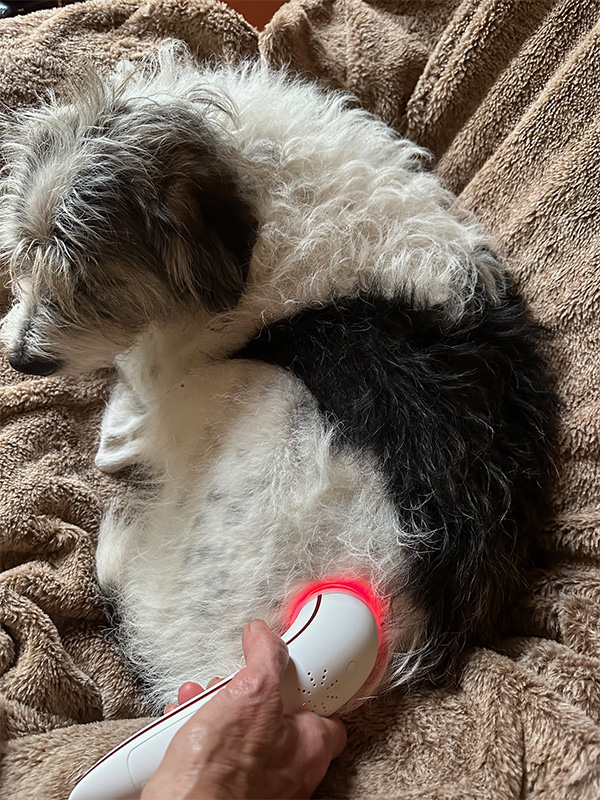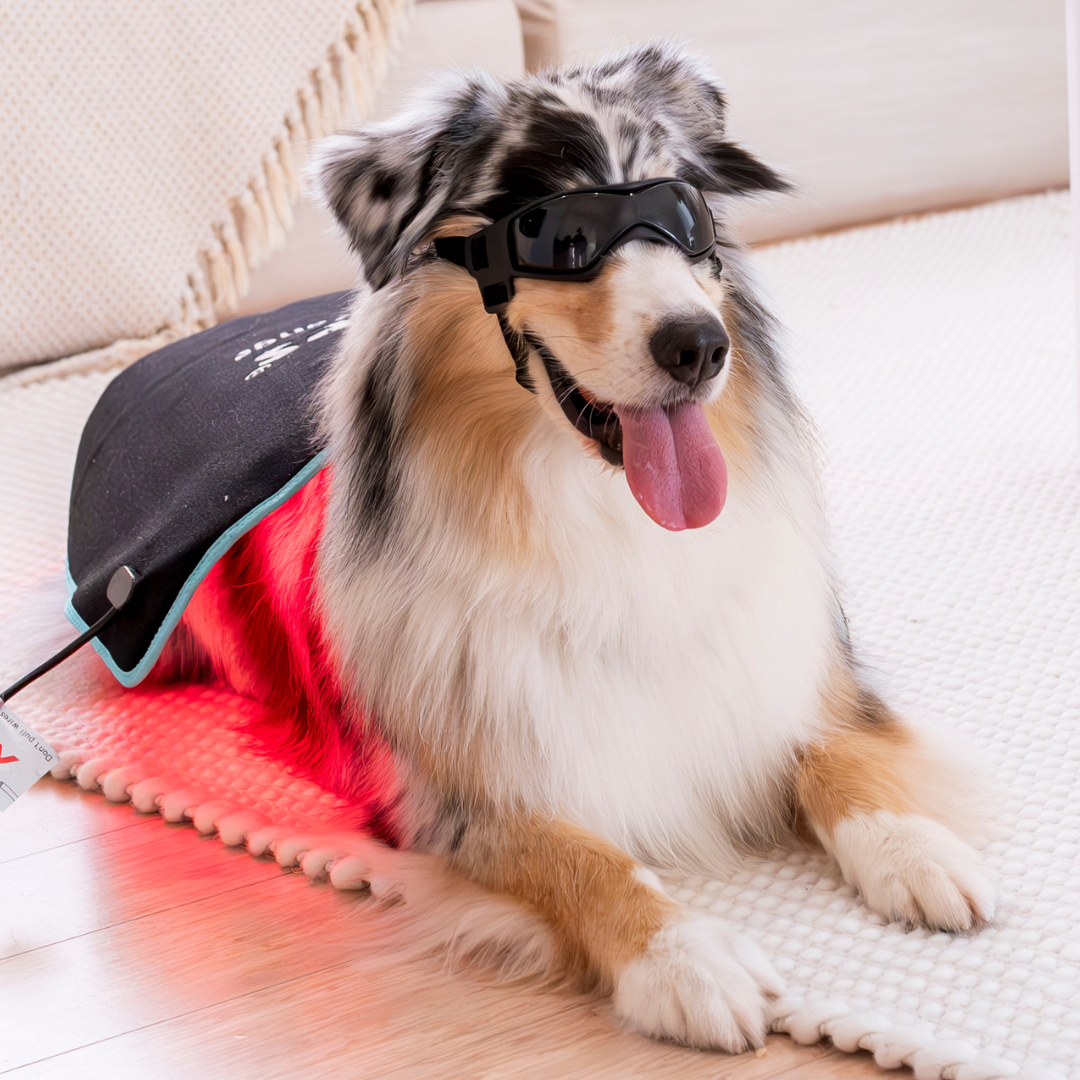Discover the Conveniences of Red Light Therapy for Your Cherished Dogs
Red Light Therapy (RLT) is becoming a promising non-invasive treatment for pets. It supplies numerous benefits, including discomfort alleviation and improved recovery. Red Light Therapy Dogs. Many dog proprietors are curious regarding how RLT can improve their pets' total health. Comprehending the mechanisms behind this therapy might reveal its potential to address typical wellness concerns. What certain advantages can RLT offer your hairy companion? The exploration begins here
Understanding Red Light Therapy: What It Is and Exactly how It Works
Red light therapy (RLT) is a non-invasive treatment that makes use of particular wavelengths of light to promote recovery and decrease swelling. This therapy utilizes light-emitting diodes or low-level lasers (LEDs) to permeate the skin, promoting cellular processes. The light energy is absorbed by mitochondria, the powerhouse of cells, bring about boosted ATP manufacturing, which boosts cellular feature and repair work.
RLT is particularly helpful for dogs, as their skin soaks up light in a different way than human beings. The therapy can enhance blood flow, accelerate cells fixing, and enhance collagen manufacturing, making it effective for various conditions. Furthermore, RLT is pain-free and can be administered in a professional setting or at home with portable devices. Its application is simple, requiring marginal prep work and no downtime, making it an enticing option for pet dog owners looking for healing services for their pets. Recognizing RLT's mechanisms can assist in appreciating its possible advantages for canine health.
Discomfort Alleviation: Alleviating Persistent Problems in Dogs
Persistent pain is a widespread concern in pets, commonly arising from problems such as arthritis, hip dysplasia, or previous injuries. Red light therapy has emerged as an encouraging non-invasive treatment alternative to relieve this discomfort (Red Light Therapy Dogs). By making use of certain wavelengths of light, the therapy permeates cells, advertising increased blood circulation and lowering inflammation. This procedure can lead to considerable pain relief for pets experiencing persistent problems
Numerous animal owners report evident renovations in their canines' movement and overall lifestyle following red light therapy sessions. The therapy not only targets discomfort directly yet additionally urges the body's natural recovery processes, giving a holistic method to pain monitoring. As an outcome, pets might experience enhanced comfort, enabling them to participate in activities they as soon as took pleasure in. In general, red light therapy supplies an important option for managing persistent pain in pet dogs, boosting their health and happiness.
Accelerated Healing: Sustaining Post-Surgery Recuperation
Red light therapy supplies significant benefits for dogs recuperating from surgical treatment by boosting cells regrowth and lowering inflammation. This treatment not just relieves pain however likewise advertises enhanced mobility and comfort throughout the healing procedure. Therefore, several pet dog owners are transforming to this cutting-edge strategy to sustain their pet dog's recovery journey.
Enhanced Tissue Regrowth
When canines undertake surgery, their bodies call for effective support for healing, and boosted cells regeneration can play a crucial role in this process. Red light therapy advertises mobile activity, stimulating the production of collagen and elastin, which are crucial for tissue repair work. By enhancing the power offered to cells, this therapy increases the regeneration of skin, muscle mass, and other tissues, helping in healing after medical treatments. Additionally, the therapy boosts blood flow, ensuring that required nutrients and oxygen get to the affected locations a lot more efficiently. Consequently, pets may experience much shorter recovery times and improved end results post-surgery. This non-invasive treatment supplies a beneficial choice for animal owners looking for to support their pet dogs' healing trip effectively.
Reduced Inflammation and Pain
Research studies show that over 50% of pet dogs experience pain and inflammation post-surgery, which can significantly impede their recuperation. Red light therapy has become a promising treatment option for reducing these issues. By penetrating the skin and stimulating cellular task, this therapy helps in reducing inflammation and advertises quicker healing. The wavelengths of light made use of in red light therapy target damaged tissues, boosting blood flow and oxygen supply, which are vital for recuperation. Furthermore, it helps hurting alleviation by regulating inflammatory actions, causing a more comfortable recovery procedure for canines. As a non-invasive and drug-free approach, red light therapy can substantially support post-surgery recovery, allowing pet dogs to go back to their regular tasks earlier.
Improved Movement and Convenience
Complying with surgical treatment, many pets have problem with restricted mobility due to discomfort and inflammation, which can considerably influence their lifestyle. Red light therapy offers a non-invasive option to support recuperation by advertising boosted mobility and convenience. The therapy utilizes particular wavelengths of light that permeate the skin, boosting cellular fixing and enhancing circulation. This process helps in reducing swelling and accelerates healing in tissues influenced by surgical treatment. Consequently, pet dogs might experience less pain, enabling them to regain their toughness and movement a lot more rapidly. Furthermore, the calming impacts of red light therapy can lower anxiety relevant to post-surgical recuperation, contributing to a better overall emotion. Eventually, this therapy can considerably improve a pet dog's post-operative experience.
Improved Flexibility: Helping Dogs With Joint Inflammation and Joint Issues
Red light therapy provides promising advantages for pets suffering from joint inflammation and joint problems. By providing pain relief, it can boost joint feature and promote faster healing times. This therapy not only enhances mobility yet also contributes to a much better high quality of life for affected dogs.

Pain Relief System
Checking out the discomfort relief mechanism of red light therapy reveals its possible to significantly enhance movement in dogs suffering from resource arthritis and joint concerns. This restorative strategy employs specific wavelengths of light that permeate the skin, stimulating mobile processes that decrease inflammation and promote my review here healing. By enhancing blood flow in influenced locations, red light therapy aids in providing crucial nutrients while getting rid of metabolic waste, efficiently easing pain. Additionally, it activates the production of endorphins, the body's natural painkiller, adding to improved comfort for the pet. As a non-invasive treatment, red light therapy not just addresses discomfort but additionally encourages a more energetic way of living, allowing dogs to regain their excitement for daily tasks and enhance their general lifestyle.
Improved Joint Function
Enhanced joint function is a substantial advantage of red light therapy for pets, particularly those struggling with arthritis and various other joint-related concerns. This therapy utilizes particular wavelengths of light to permeate the skin, promoting cellular task and promoting healing in impacted joints. By improving circulation and lowering swelling, red light therapy assists to ease stiffness and discomfort, allowing canines to regain their movement. Pet proprietors usually observe that their pet dogs show improved variety of motion and boosted willingness to engage in exercises. As a non-invasive treatment option, red light therapy acts as an efficient complementary approach to traditional methods, offering a holistic option to sustain joint wellness and enhance the lifestyle for pet dogs with chronic joint troubles.
Faster Recuperation Times

Improved Power Levels: Improving Total Vigor
While numerous pet dog proprietors look for methods to enhance their canines' health and life, red light therapy has arised as an appealing option. This non-invasive treatment makes use of details wavelengths of light to stimulate cellular feature, which can lead to boosted energy degrees in dogs. By promoting far better blood circulation and lowering inflammation, red light therapy assists to invigorate the cells, eventually increasing general vigor.
As canines experience raised energy, their capacity to take part in play and exercise boosts, resulting in a more active way of life. This can be especially helpful for older pet dogs or those recuperating from injuries, as they might have lower power levels because of pain or pain. Regular sessions of red light therapy can assist transform an inactive animal right into a much more lively and lively companion. Eventually, this therapy not only improves energy levels but also adds to the total well-being and happiness of beloved dogs.

Safety and security and Considerations: What Canine Owners Ought To Know
Prior to beginning red light therapy for pet dogs, it is necessary for family pet owners to understand the precaution and factors to consider involved. Consulting with a veterinarian is important to assure the therapy is appropriate for the specific dog's health condition. Some breeds or pets with certain clinical problems may react in different ways to red light therapy.
Pet dog owners need to additionally confirm the equipment utilized sends out the proper wavelength, commonly in between 600 to 1000 nanometers, to accomplish effective outcomes. It is necessary to adhere to the suggested period and distance during treatment to stop overheating or skin irritation.
In addition, keeping an eye on the pet's feedback throughout and after sessions is vital; any indicators of discomfort or damaging reactions should trigger instant cessation of therapy and appointment with a vet (Red Light Therapy Dogs). By sticking to these standards, dog proprietors can take full advantage of the advantages of red light therapy while preserving their pet dog's safety and wellness
Frequently Asked Concerns
Exactly how Usually Should I Make Use Of Red Light Therapy on My Dog?
Red light therapy for dogs is normally advised 2 to 3 times weekly, relying on the particular condition being dealt with. Appointment with a vet warranties proper frequency and period customized to every dog's specific needs.
Can Red Light Therapy Be Made Use Of Along With Other Treatments?

Is Red Light Therapy Suitable for All Pet Breeds?
Red light therapy is normally suitable for all pet dog breeds. Individual health conditions and sensitivities might vary. Consulting a veterinarian ensures the therapy is proper for a particular pet's circumstances and requirements.
What Should I Anticipate Throughout a Traffic Signal Therapy Session?
Throughout a traffic signal therapy session, the dog typically loosens up in a tranquil environment while the specialist uses specific wavelengths of light. Sessions usually last 15 to 30 mins, promoting healing and convenience without discomfort.
Exist Any Side Results of Red Light Therapy for Dogs?
Negative effects of red light therapy for canines are normally very little, with some experiencing moderate inflammation or heat at the treatment site. Seldom, canines might reveal short-term discomfort or anxiety, but serious adverse effects are uncommon.
Red light therapy supplies substantial advantages for dogs recuperating from surgery by boosting cells regeneration and lowering swelling. Exploring the pain relief device of red light therapy reveals its potential to significantly enhance flexibility in pets suffering from joint inflammation and joint issues. Boosted joint feature is a considerable benefit of red light therapy for dogs, especially those suffering from arthritis and other joint-related concerns. By improving flow and lowering swelling, red light therapy helps to reduce tightness and pain, permitting dogs to restore their wheelchair. During a red light therapy session, the pet dog normally unwinds in a calm setting while the specialist applies particular wavelengths of light.